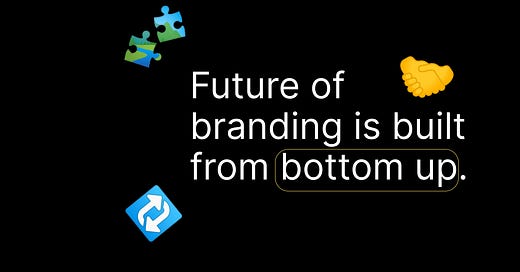Community Padawans,
It’s Francisco here! 🙌
I am back! If you’ve been following me for a while, you know that I’m all about building meaningful communities.
But today, I want to take a step back and reflect on something that’s fundamentally reshaping branding as we know it: community-driven branding.
In a world where every brand seems to be competing for attention, it’s no longer enough to rely on flashy marketing campaigns or the perfect visual identity.
The future of branding is about something much more powerful: the community that grows around it.
But I’m not talking about the kind of community you find on Instagram or Discord. I’m talking about the kind of community that co-creates, shapes the brand's identity, and becomes a core part of its story.
So let’s dig into why community is no longer a buzzword, but the foundation for building lasting brands.
The Evolution of branding: from push to pull
Let’s start with a question: do you ever think about how branding used to be done?
For years, brand-building was straightforward. You defined a position, created a strong visual identity, and launched campaigns. The goal was simple: get consumers to align with your narrative.
But this model? It’s losing relevance.
The future of branding isn’t about defining a perfect narrative and hoping customers will buy into it.
Instead, the strongest brands today are born from passionate communities—communities that don’t just consume products, but actively shape the brand and its identity.
It’s a huge shift.
If your brand still thinks that simply creating an Instagram group or a Discord channel is enough to build community, it might be time for a rethink.
True community-building requires more than just a space for people to interact—it’s about engagement, co-creation, and creating shared values.
A community isn’t an audience. It’s a co-creator
Let me give you some examples of brands that have nailed this shift.
Brands like Glossier, Tracksmith, and Notion didn’t just create loyal followers—they built communities where their customers had a real role in shaping the brand.
Glossier began by asking for feedback from its community to help develop new products. This wasn’t just about product suggestions. It was about co-creating the future of the brand.
Tracksmith built a running brand that feels like a secret club for those who truly care about the sport. It’s not just about selling products. It’s about creating an experience that members feel they own.
Notion took community feedback and not only listened but incorporated that input directly into the product.
This is the key difference between a brand and a community: a community doesn’t just consume—it participates.
If your customers don’t feel they can make an impact, you don’t have a community. You’ve got an audience.
Community needs a purpose beyond the product
Here’s a big mistake many brands make: creating a group and then filling it with promotions and product launches. That’s not community-building.
That’s just a sales channel with a nicer name.
Instead, look at brands like Patagonia and Athletic Brewing Co.
They understand that people don’t just gather around products. They gather around causes, values, and shared experiences.
Patagonia is more than just a brand that sells outdoor gear: it’s a movement. It’s about environmental responsibility and protecting the planet.
Athletic Brewing Co. doesn’t just sell non-alcoholic beer. It represents an active, no-compromise lifestyle that resonates deeply with its community.
If your community only exists to sell products, it will never grow organically. It needs to be about something much bigger.
Community has the power to define the brand
Now, let’s get into the real power of community.
What if, instead of making decisions for your community, you let them help shape the brand itself?
Brands like Liquid Death and Huel have mastered this concept.
Liquid Death took something as simple as water and turned it into a symbol of rebellion. What started as a simple product became a community-driven brand that feels more like a rock band than a bottled water company.
Huel doesn’t spend millions on traditional advertising. Why? Because its community of loyal customers are its biggest advocates and ambassadors. They share the message, they shape the identity.
And then there’s Lululemon. They didn’t just build a fan base around activewear.
They created a community of ambassadors who don’t just wear the product: they live it.
They organize events, influence product designs, and represent the brand’s core values.
Similarly, Ten Thousand ensures that its athletes have a hand in developing every piece of clothing, making sure the brand is about much more than performance. It’s about community.
To have a truly impactful community, you need to give it real power.
Let them shape your brand’s identity. Let them co-create with you.
The new branding is built from the ground up
Here’s the big takeaway: the future of branding isn’t about pushing products from the top down. It’s about building an organic, participatory community from the ground up.
So ask yourself: Are you ready to build a brand that isn’t just a business, but the heart of a community?
Questions to reflect on
Before I leave you, here are a few questions to get you thinking:
Do my customers feel like they are part of the brand?
How can I give my community real influence in shaping my brand’s decisions?
Does my product bring people together based on what they believe in, or just what they buy?
Let’s keep the conversation going!
I’d love to hear your thoughts on the future of community-driven branding.
Which brands are inspiring you to create a community that’s not just about selling, but about co-creating and building something bigger?
Leave a comment below or shoot me a message. I’m always open to hearing your take on this!
Thanks for reading, and stay tuned for more insights on community-driven branding and how it’s changing the game.




What an incredible piece! Thanks a bunch for sharing this.